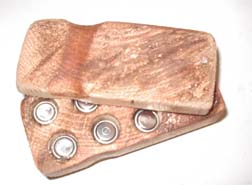| / | How to Tape a Deben Collar
There's nothing quite as frustrating as a Deben collar that goes dead in the hole. The most common reason for this event is that water has worked its way into the collar, even if it has been taped. The good news is that it is possible to keep a collar tight against the water if certain steps are taken.
Simple Deben Collar Improvements The two collars shown below suggest two simple improvements you can make to a Deben collar that will help keep them water-tight.
Deben collars normally have two small transistor wires that are barely coated by the normal plastic coating of the collar. When that coating is worn away, water enters the collar and oxidizes the internal circuits, which makes the collar go on the fritz. Collars die because of water entry, and nothing is more important to the life of the collar -- and the life of your dog in the hunt field -- than keeping water out of the collar. A second tip is to slip a very tight O-ring between the battery cap and the hard plastic body of the Deben transmitter. Both collars, above, have a black O-ring in place. O-rings can be purchased at any hardware store and cost only a dime or two, but they provide a fairly good seal right at the cap where it is most needed.
How to Tape a Collar Tape Deben collars well before you get into the field -- taping a collar while everyone else is waiting, dogs are barking, your fingers are numb from the cold, and your mind is half adled from excitement, is a guarantee of a job poorly done. 1. First, put in the correct batteries! These should NOT be zinc air batteries, as they will quickly go dead regardless of how well you tape up the collar as zinc air batteries depend on access to fresh air to work. You want two single-height batteries per collar, or one double-height battery. In my opinion, silver-oxide batteries are no better than alkaline batteries even though they cost quite a lot more, and they are mechanically interchangeable. Single-height brands and types that work well are Duracell D375H or D393; Panasonic SR44W or SP357 or ST48W or SP393; Ray-O-Vac RW42 or RW48; or an Ever Ready BSR 44H or BSR 48H or BSR 48L, or any button battery labeled AG-13. If you prefer a double-height battery, use a Duracell DL1/3N lithium battery which can be gotten at Home Depot, a camera store, or from Radio Shack. This battery is also sold as 2L76, and CR1/3N. Mark each battery with a sharpy felt tip on the side -- one mark for every day in the field. After the third mark, throw the battery away and put in a new one if you are not going to invest in a $5 button battery tester (available from any Radio Shack and a strongly recommended investment in economy and safety). 2. Tighten the screw cap down finger-tight. Be careful not to strip the threads -- start it correctly! If you have fitted a collar with an O-ring (see tips above), it is a bit harder to overtighten the collar cap. 3.
Always use plastic
electrical tape to tape collars. I use the 3-M brand
available from Home Depot.
7.
Carefully press
down the poofed sleeve of the tape to seal up the end of the
screw cap.
8.
Start a new wrap at the
plastic end of the transponder, but this time wrap
the transponder lengthwise, with the tape running down the side
of the transmitter, from the plastic butt end to the
butt end of the metal cap. Wrap lengthwise twice,
making sure the tape is well-centered at the cap end.
Cut the tape, or pull it until it breaks. Pat the
tape down so everything sticks tight.
10. Test the collar. There is no other sure-fire method of making sure the batteries in the collar and the battery in the box are both working. You should get a loud and clear clicking
Collar Maintenance After Leaving the Field Take out the batteries at the end of every day's dig and clean the leather collar with water to get off the dirt. Oil the leather strap every other outing, and hang the collar on a nail to air dry and to protect the leather. The leather will last a long time if not left to rot. Batteries can be reused again, but it's not a bad idea to change batteries after every three days of use, and a $5 battery tester from Radio Shack is an investment in your dog as well as peace of mind.
Deben Collar Battery Storage A small wooden box for battery storage is an easy thing to make. Simply rip an inch and a half off the end of a two-by-four and then take a half-inch drill and bore a series of holes into the end grain. Rip another half inch off the two-by-four, and that's your top. A small brad nail is the pivot point for the lid, and a rubber band keeps the whole thing closed. Sand a bit and there you have it. With this little custom box, your Deben batteries won't roll around, won't get lost, and won't discharge when not in use. An alternative system for battery storage is to seal the batteries between layers of the new Glad "press-n-seal" and keep the batteries in a small plastic pill box. Use double layers of the plastic in order to make sure there is no electrical migration at all through the plastic. A third alternative is a small wood or plastic box filled with Styrofoam (the urethane foam from a child's "noodle" swimming pool float is excellent). Cut the foam to fit the box, and then use a hot nail to burn a hole in the foam that is the same size as a collar battery.
Some of the folks that use two small batteries in a collar simply reverse the batteries and put them back into the collar. They last a long time this way, but some discharge may occur and I recommend against it. A dog should never be lost due to poor battery storage -- don't be lazy!
To order a Deben box or collar, see: http://www.terrier.com/newstore/dept.php4?dept=working
|


